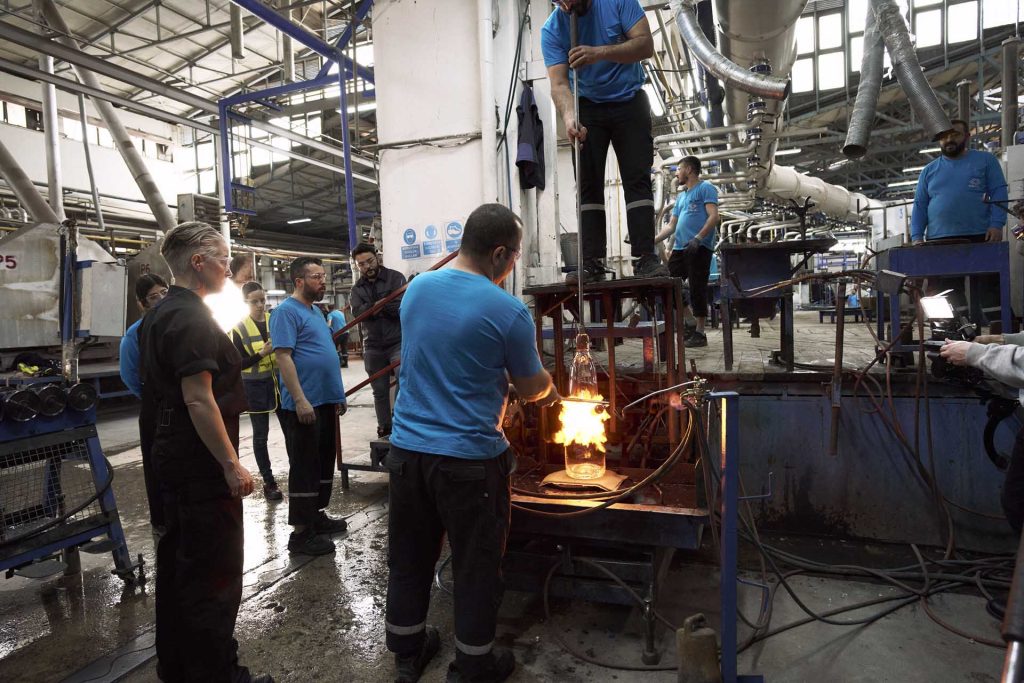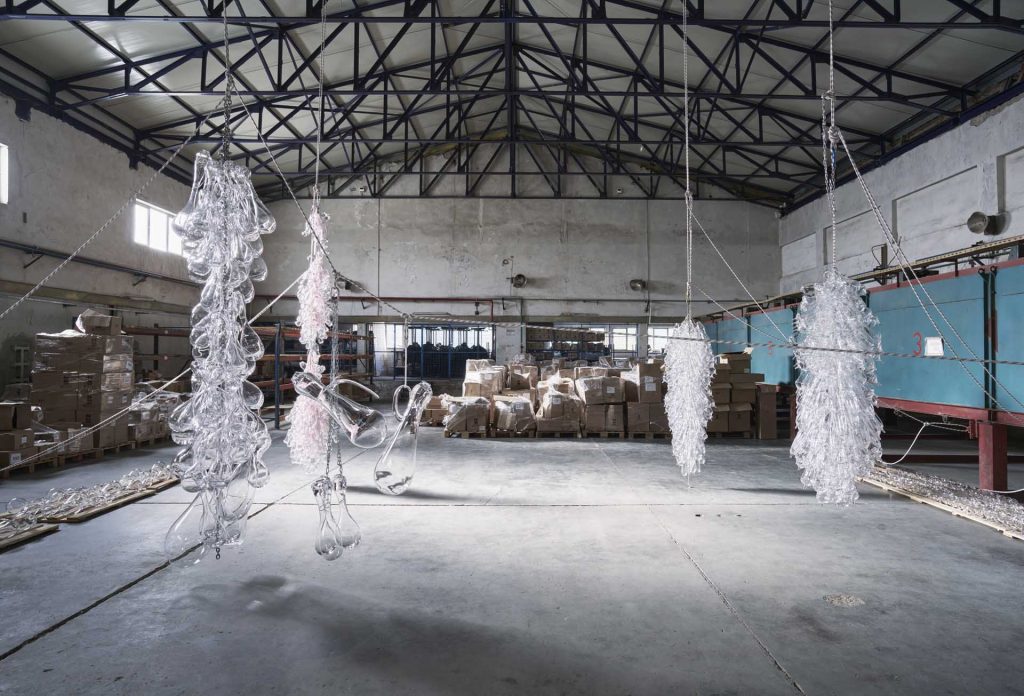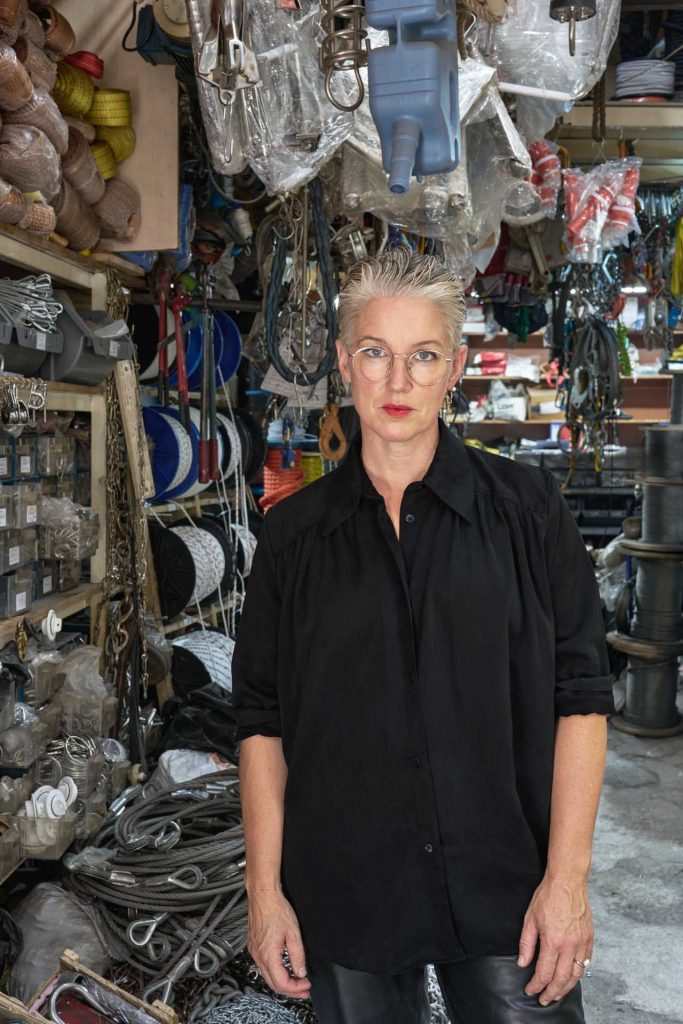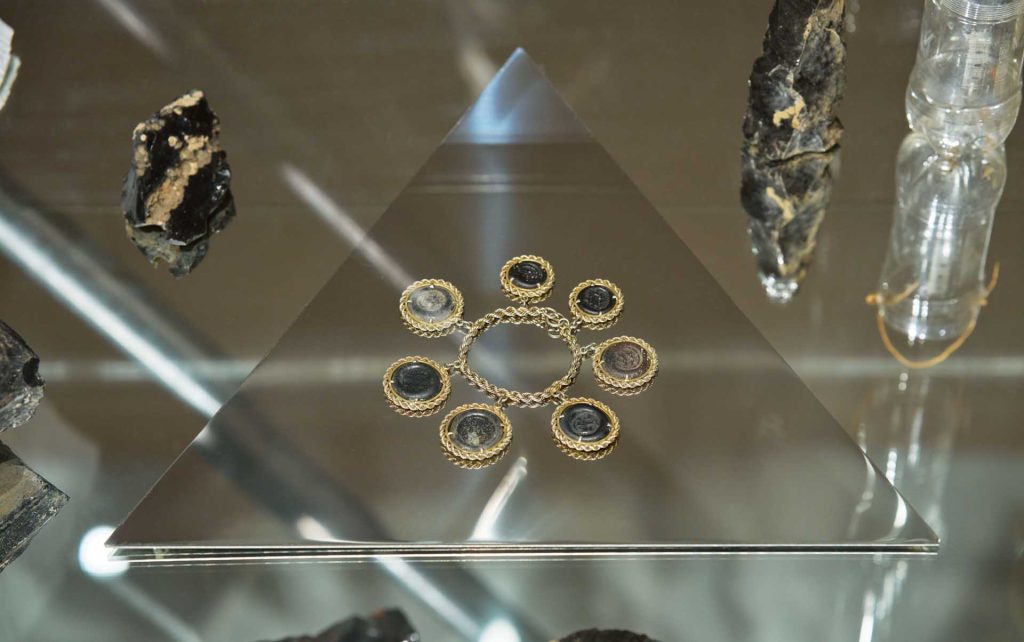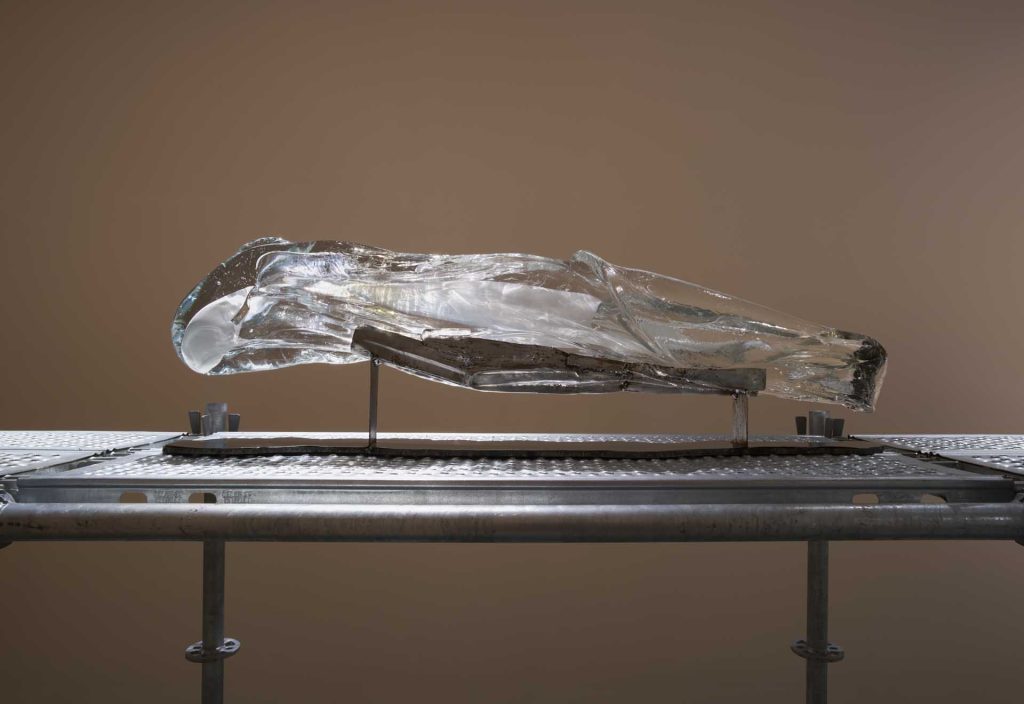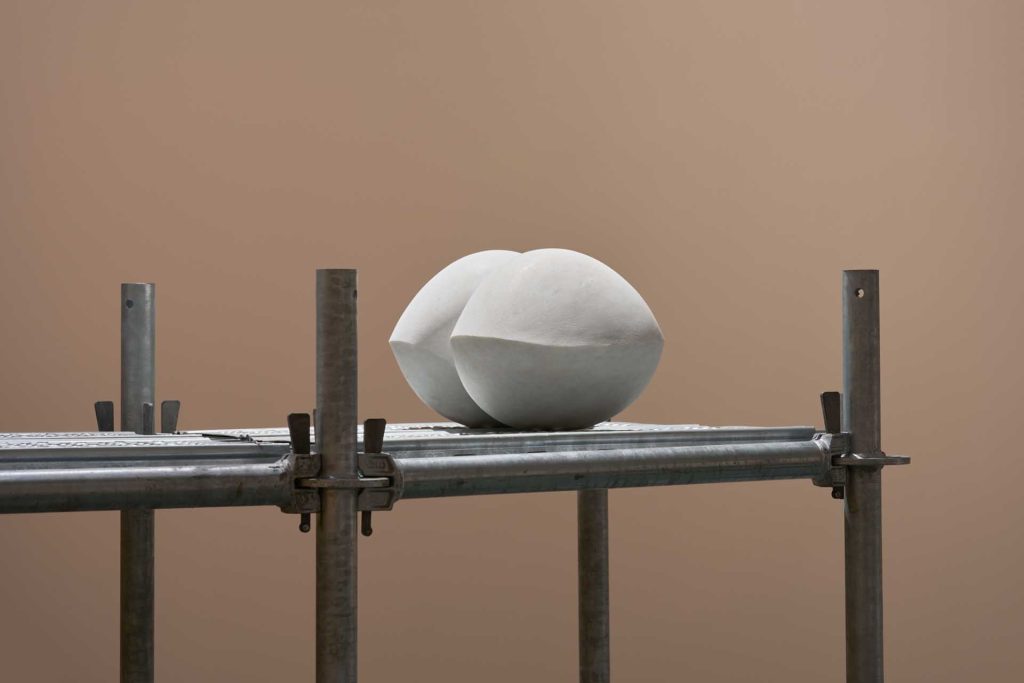
The Suna and Inan Kirac Foundation Pera Museum brings together the works of Swedish artist Åsa Jungnelius in the exhibition “A Verse, Written with Earth, Fire, Water, and Air.”
Created over several months, Jungnelius’ pieces draw inspiration from and were shaped through collaborations in Türkiye – from her forest-based glass studio in Sweden to the skilled artisans of Denizli SiseCam Factory. The exhibition also establishes an existential dialogue by combining these works with pieces from the museum’s collection and loans from the Sadberk Hanim Museum. Jungnelius believes that disciplines such as sculpture, painting, photography, and art history – as well as time and patience – actively participate as materials in the creative process.
Celebrating its 20th anniversary, the Suna and Inan Kirac Foundation Pera Museum hosts Swedish contemporary artist Åsa Jungnelius’ solo exhibition “A Verse, Written with Earth, Fire, Water, and Air,” on view until January 18, 2026. The project serves as a photographic, sculptural, and architectural documentary of the artist’s multidisciplinary collaborations across various regions of Türkiye. Accompanied by a comprehensive catalog, the exhibition gains documentary quality, intersecting the Suna and Inan Kirac Foundation’s rich art-historical heritage with Jungnelius’ creative practice.
Supported by the Consulate General of Sweden, with Sisecam as production sponsor, and featuring works on loan from the Sadberk Hanim Museum and the Weights and Measures collection of the Foundation, the exhibition reflects a dialogue between artistic labor and cultural legacy.
Curated by Elif Kamisli and officially supported by the Swedish Research Institute in Istanbul (Wall Heritage), the exhibition’s graphic design was developed by Yelta Kom – Studio No Frame and Pelin Gezer. The learning programs were led by Selma Hekim, Baris Bilgen, and Muge Isigollu Sedola, while the film and video program was coordinated by Gulcin Kaya.
Brought to life through the mastery Orrefors KostaBoda artisans and Sisecam glass craftsmen, “A Verse, Written with Earth, Fire, Water, and Air,” takes inspiration from Åsa Jungnelius’ journey to the obsidian beds of Eastern Anatolia.
Presented for the first time in Türkiye at the Pera Museum, Jungnelius’ works include pieces in which she transforms glass from simple forms into abstract expressions. Another key aspect of the project is the collaboration with Swedish photographer Peo Olsson, whose lens captures and documents the artist’s creative journey throughout the process.
Curator Elif Kamisli first met Jungnelius in March of the previous year at the historic Swedish Consulate, originally built in 1870 and later restored. Jungnelius, whose works were also featured in Pera Museum’s 2014 exhibition “Aurora – Contemporary Nordic Glass Art,” is celebrated by curators, academics and critics alike for her feminist perspective reflected in her glass art and design.
The artist behind “A Verse, Written with Earth, Fire, Water and Air” is also a devoted mother – her young son’s name, “Sten,” means “stone” in Swedish.
Elif Kamisli summarizes her reading of the artist in the catalog text as follows:
“…From time to time, she pauses to let the soil or the material tell her what it has to say, allowing the environment she is in to permeate her. She is not afraid to step into the unknown – whether mentally or physically. Unlike many people, she does not hesitate to embrace the uncertainty and darkness she encounters when she gets lost in the process. What enables this is her knowing, with the wisdom and instinct of the adventurer, that in order to find one’s way, one must first get lost…” (1)
The artist, born in 1975 in Stockholm and who values collective production in her work, collaborates on this journey with curator Kamisli and with the SiseCam factory established in Denizli in 1935 by Atatürk’s order. Jungnelius’ closeness to glass art began at the age of 17, when she met a young girl in a parking lot and was impressed by her glass necklace. After receiving directions to the origin of the necklace, she travelled to Smaland, known as the “Crystal Kingdom”. Adding the Orrefors region and the experimental glass school experience she gained in Brierley Hill in England to her education there, the artist sees glass as a material that mediates between her inner world and the outer world surrounding her, giving her the opportunity to shape her thoughts.
Due to the project, curator Kamisli also makes a journey to Aphrodisias, the archaeological site of the region. While the city is immortalized once more today through Ara Guler’s iconic frames, its excavation history is indebted to Archaeologist Prof. Dr. Kenan Erim, who brought the site to light.
Another pillar of the exhibition at Pera Museum is the “obsidian memory” exploration that the artist Jungnelius documented and discovered together with photographer Peo Olsson – extending from Mus to Kars, then to the Ani Ruins and the foothills of Mount Agri. Accompanied again by curator Kamisli and guided by Ferzan Demirtas, the duo traveled roughly 900 kilometers within four days, following the borders of Iran and Armenia. The term obsidian refers to “lava that has cooled rapidly in its natural form.” As curator Kamisli notes, the work created by the artist “… draws its strength from a collective effort. In this process, embracing the unknown also means accepting imperfection, one of the inevitable qualities of existence. (2).
The Asa Jungnelius exhibition at Pera Museum, as outlined above, embraces the value of uniqueness that emerges through the distinctive forms contributed by various glassworkers with their own breath. The exhibition, where stone, glass, and metal seem to create a cosmic “chamber music,” is also marked by the artist’s sculptures that evolve from figurative to abstract. As curator Kamisli interprets, “…the sculptures that emerge through interventions in the production flows of functional objects in Denizli capture something impossible to accumulate — ‘air’,” thus giving life to the conceptual third pillar of the exhibition.
To quote Kamisli again, “Asa Jungnelius’ exhibition can also be read as a verse written over the course of a year, in collaboration with the elements of Earth, Air, Fire, and Water. Centering the artist and her relationship with materials, the exhibition brings together her recent glass and marble sculptures with a series of works produced specifically in Denizli for this presentation.” (3)
As these are read, the catalog texts by Tim Ingold and Bodil Peterson—enriched with art-historical, social, and political layers and inspired by the artist’s labor—further illuminate the richness of the action Jungnelius displays in her exhibition. Peterson’s text, which traces the footprints of glass, blends with Ingold’s aesthetic and poetic writing that analyzes the “structure” of glass and marble.
The exhibition brings forth a surreal museum world by intersecting its metal construction with a tender pink–brown tone. In this charismatic choreography, where the artist nearly brings an ancient plumb line into contact with infinity through a mirror, we witness an existence suspended in the fatal pendulum of what we call life and death, both singular and universal. The event is experienced as a contemporary stage–set proposal, conceived through a raw, operatic acoustic that conveys life with unusual, singular objects.
These works celebrate the ease of being both found and created without looking down on one another. With every encounter, they gently and subtly draw yet another line over our notions of beauty and uniqueness.
The sharpness, sincerity, fragility, and clarity infused into the soul of the glass that brings the exhibition to life—blown into being through the devoted labor of the artist and her team—serve as ethical metaphors for our contemporary understanding of art and history.
In the simplest terms, the event creates a ground for discussing how we might look at “matter” and journey from it toward “meaning.” Through the destiny of matter, it tests again the “expiration date” of both human existence and narrative. In doing so, it reproduces itself within the interdisciplinary museum filled with classical works it temporarily inhabits, conveying an effect akin to an in vitro fertilization on behalf of the permanence of knowledge, value, and archival memory.
For this reason, within the exhibition—which embraces its own delicacy and self-contained hygiene—many pieces, from early Islamic glass scale weights to a bracelet used in Egypt in the early twentieth century, and further to vessels such as ancient cups, pitchers, feeders, small amphorae, or bottles, can joyfully encounter the contemporary art pieces of “A Verse Written with Earth, Fire, Water and Air,” emerging from the Suna ve Inan Kirac Foundation Anatolian Weights and Measures Collection or from the Sadberk Hanim Museum.
Among these works, the artist’s pieces such as “Intense Hot Core II” (2024) and “Mother” (Breath I) attract considerable attention. The abstract glass form “Bitter-Sweet” in the exhibition even offers, with all its poetic force, a subtle parallel to a mischievous comet saluting Mother Nature as it passes through the atmosphere—or to that fleeting moment of overlapping existence created by two bodies coming together in pleasure.
Jungnelius also presents her commitment to approaching the notion of production through a feminine lens of abundance—something she has made a professional principle—through her new, sensually charged works like “Perfect Transformation” (2024) and “Mortar.” Abstractions such as “I Can Carry You Too” (Breath IV) and “Into My Arms” further intensify the exhibition’s sensory, sexual, and fertile aesthetic.
Meanwhile, the images that photographer Peo Olsson captures in Türkiye continue to follow the roots of the narrative like a cultural visual subtitle. The artist, who holds an Honorary Doctorate from Linnaeus University in Sweden, also shares heartfelt remarks in an exclusive interview with Arkas News, bringing this atmosphere even closer to us.
There is an effect in the exhibition that makes us oscillate between power and fragility. Is this part of your symbolic or principle-based artistic practice?
Yes, indeed, I make a great effort to “listen” to the material and to what it has to say. Through this, the artworks can respond to me as an individual. I believe that we humans already carry this fragility and strength within ourselves. In this exhibition in Türkiye, I think the idea is that through the material of glass, we, too, embark on a kind of discovery—and perhaps most importantly, realize that we all exist within this geography where this experience takes place.
This of course includes the forest studio in my own country, Sweden, where I live and produce. At night it is pitch dark, silent, and still. I have to be there to be able to hear what the material tells me. So in the exhibition, I show you what I heard and saw in those moments. With this exhibition, I show how this became a form of necessity for me—an urge to express it.
For example, the first work at the entrance of the exhibition—where we used a historical plumb bob, organic rope, and mirror—essentially explains that all of us exist within the same system in the universe and that, in a way, we all fall right into its center through gravity. With this work, I reinterpret an object once used for authority through my own narrative, and while doing so, I use an organic fiber rope sourced from nature and co-produced with my artist friend Marcus Wallin.
Does “hospitality” play a major role in your work?
On the path toward my artworks, I enter into collaborative production with many experts in their fields. For example, with our photographer Peo Olsson, we have a long-standing shared effort and friendship. I combine this way of working with long periods of solitude. I also need time to work with the material on my own. But I think human relations and working with them are also a kind of material, and I truly enjoy being in that process. In this way, while working on a piece, I also enter a process I know nothing about. People and the places I visit end up shaping the forms of the works I create.
It is also understood that you refer to the gender and fertility of things in your work. The order, disorder, and value of things also appear as elements you explore. In this sense, your works gain a philosophical dimension. Observing your pieces, I often think of a figure like Joseph Beuys. How would you describe the way you place your works side by side with art history?
Thank you for this thoughtful observation. As an artist, of course you have connections with art history. As part of this chain, I, too, am able to connect with other artists both conceptually and philosophically. This includes artists who are still alive today. After all, art is a shared collective of knowledge. In a way, I am someone included in this tradition.
For example, Louise Bourgeois. What do you think about her?
Oh yes, I love her very much. I think she is the mother of sculpture. I have great respect for her works. I am proud that her pieces came before mine in art history. In a way, she is also part of the reason I am able to express myself so freely today.
Likewise, your works seem very concerned with the “health” of things. In that sense, they are abundant—ecological, biological, and, as you often say, connected to “Mother Nature.” Almost medicinal.
Yes, it can certainly be said that my early works carried very strong feminist influences. I think this exhibition reflects who I am 20 years later. In this sense, through my relationship with Mother Nature, they also speak deeply to the fragility of things and of humanity. For example, we are beings who experience many processes in our bodies at the same time. Sharing these experiences holds a special place for me. Yes, my early works, 20 years ago, were in a sense “screaming, angry” works. But as I have grown older, this tendency has moved toward much greater diversity. This is something that relates to the condition of being human.
Do you have any other art-historical references?
Of course, besides Louise Bourgeois, we can mention Niki de Saint Phalle.
Do you work with “apprentices”?
I mostly work with people who are experts in a specific field. This allows them to reflect a stronger presence in their own way. In this way, we are able to blend that knowledge together. I have an approach that sees people as stronger when they stand within what they already know. This way, they do not end up being mere followers. Because if you are a distinct individual, that is better. Along with this, we also carry out joint projects with young creatives in glass studios in Sweden, and I get the chance to observe how they are influenced. So yes, I do end up teaching them at times.
What is the role of accidents in your works, which attract attention with their highly fragile nature? How do you anticipate these? Are there insurance processes involved?
Interestingly, once these works enter the museum or the place where they will be exhibited, they actually become stronger—of course, as long as there is no obvious fragility in my studio
Have you created any public-space works? For example, is there such a work in your home country, Sweden?
Yes, I have such a work in Sweden. At the same time, I am working on a massive project for a train station. I am also working on another project called “Shell,” which is a tribute to motherhood. I have been working on this piece for 10 years, and it will be completed in about two years. Yes, I have such works, and I also create site-specific, experimental, and process-based pieces. For example, I have a project where I placed a gigantic hot-air balloon inside an old oil factory. I developed this piece so that people could experience feeling as if they were trapped inside it. I have always been fascinated by the way people relate to art in public spaces.
Another inevitable material in your works must be time. You are very patient, and this patience becomes a material in itself. Your works seem to shape bodies and spaces frozen in time.
Yes, how many hours I spend working on something never affects me. It may take hours, days, or even longer. I believe this is connected to learning the traditional craft at a very early age and later realizing that both the work and the artist need time. You need time to do things properly. In fact, for some of the works I created for this exhibition, I spent far more time than I did with my own family—years, not just hours or days.
While walking through the exhibition, interestingly, we feel almost as light as a bubble. We drift and float from one work to the next.
Hearing this makes me very happy!
Kaynaklar:
- “Toprak, Ateş, Su ve Havayla Yazılmış Bir Dize” sergisi kataloğu, s.49-52, Küratör Elif Kamışlı, Sergi Kavramsal Metni
- “Toprak, Ateş, Su ve Havayla Yazılmış Bir Dize” sergisi kataloğu, s.72, Küratör Elif Kamışlı, Sergi Kavramsal Metni
- “Toprak, Ateş, Su ve Havayla Yazılmış Bir Dize” sergisi kataloğu, s.75, Küratör Elif Kamışlı, Sergi Kavramsal Metni
- https://www.peramuzesi.org.tr/sergi/-asa-jungnelius/1316



